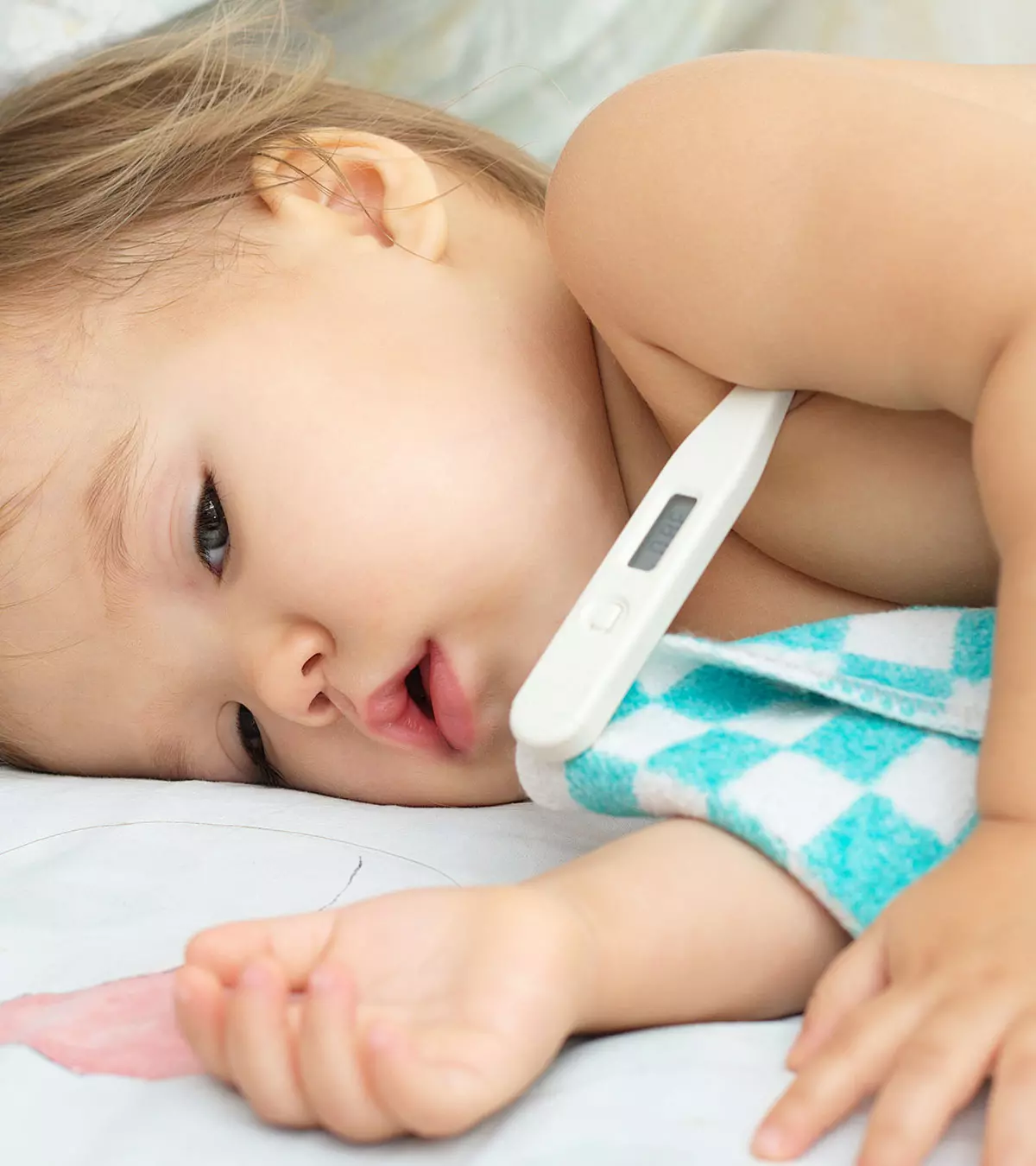

Image: Shutterstock
According to the American Academy of Pediatrics (AAP), you may start bottle feeding the baby after exclusive breastfeeding of six months (1). While some may keep transitioning between bottle feeding and breastfeeding, others may depend on the bottle solely. This can be due to factors like inadequate breast milk, personal choice, or any other underlying condition. Before introducing the bottle to your baby, you need to know the position and hold for safe and easy feeding. In addition, the bottle needs to be checked and sterilized thoroughly before giving it to the baby. This post will tell you about all the requirements and steps to be followed while bottle-feeding your baby.

How To Bottle-Feed A Baby?
Bottle-feeding is the process of giving expressed breast milk, donated breast milk, and/or formula milk to an infant, through a bottle.
Though both bottle and breast feedings involve correct positioning and effective latching, some babies might take more time getting used to the bottle than to the breasts.
Here are a few simple ways you can help the baby:
- Get the position right: Fold your hand at the elbow and place your baby’s head in your upper arm and the other arm should be around the baby or hold the bottle. The baby’s head should be in an upright position and not flat on her back.
Note: Don’t feed the baby while she is lying down as the formula milk can pass into the middle ear causing an ear infection (2).
- Sit face-to-face: An alternative position is to rest your baby with her head on your knees and the feet on your belly. You will be facing each other making enough eye contact while feeding.
- Slant the bottle: When you are feeding, slant the bottle till the teat is full of milk. This decreases the air that your baby might probably gulp in, thereby decreasing the chances of gas in the stomach. Burping halfway and at the end of the feeding brings out any air intake.
- Use a pillow: Some babies love to be fed while lying on a pillow. Remember to hold the bottle for her and don’t leave her unattended. Paced bottle feeding method is one of the best and safest ways to bottle-feed a baby.
It’s all about timing (how old is baby when introducing a bottle for the first time) and the bottle/teat/ flow used to bottle feed.
Care To Take While Bottle-feeding The Baby
Some babies refuse to drink from the bottle. It can be a challenging task to get them used to the bottle. Try these tricks:
- Feed when the baby is hungry: Sticking to a feeding schedule might not work with bottle-feeding. Babies are likely to have two ounces of milk in one hour. Look out for signs of hunger such as opening mouth, turning head side to side, sticking out tongue, making smacking noises in the air, bringing hands to mouth, crying is a late hunger cue. sucking thumb, getting fussy or squirmy, and then feed accordingly. Your baby will feed at least 8-10 times during the day, so make sure you have enough bottles to feed them.
- Never force the baby: Don’t force the nipple into your baby’s mouth. If your baby is not in a mood to eat, don’t force them. That can result in negative association with the feeding time. Give them a break.
- Check the nipple: Check if your baby is comfortable with the nipple. If they are not getting used to it, change the model of the nipple. You may try a couple of them before figuring out which one suits the best for your baby. If your baby is on a pacifier, try a nipple with the same shape.
- Observe the flow of milk: Make sure that the milk is flowing slowly and consistently. Follow baby’s natural pauses or let them swallow 10-15 times and then give a break. You want to avoid overfeeding which leads to childhood obesity. If milk is coming out the sides of baby’s mouth, flow is too fast. Slow it down and use a slow flow teat.
- Check the plastic: If you are buying plastic feeding bottles, buy food grade plasticware that is BPA-free (3) or go for glass feeding bottles. Remember to sterilize the new bottles before using unless there are any specific instructions.
- Sterilize the bottles: This is the most important thing to do when you are bottle-feeding your baby. Sterilizing in tap boiling water for 5-10 minutes works depending where you live. Also, steam bags work well for sterilizing bottles and other parts. Dishwater with a sterilizing cycle also is acceptable. Dry the bottles and keep them in an airtight container to avoid contamination.
- Preparing formula: The recommended safest way to prepare powder formula is to boil the water to be used and then mix the hot boiled water with powder formula following the product instructions. Do not let the water to cool down before mixing. The point is that the hot water will kill any contaminants in the powder formula. After mixing well, run bottle under cool water to cool down and test on your wrist before feeding to baby. It should feel lukewarm.
- Measure the formula: Follow the instructions on the pack for preparing the formula. If the formula is too much or less, your baby’s tummy can get upset or they might not get the right amount of nutrients.
- Check the temperature of the feed: The feed shouldn’t be too hot or cold. It should be just warm. You can check the temperature by placing a drop of milk on your wrist or by placing the bottle on your wrist.
- Don’t warm the bottle in the microwave: If you want to warm the bottle, use a bottle warmer or immerse it in a vessel of warm water. Microwaving does breaks down the nutrients in the formula and also warms it unevenly.
- Clean the bottles: Clean the nipples, retaining rings, and the bottles with warm soapy water using a bottle brush. Rotate the brush inside the bottle to remove any residue of milk or milk powder. Ensure there are no traces of milk and rinse them thoroughly. Have a designated brush/sponge just for bottle and feeding parts. Let the cleaned parts air dry on clean paper towel or on a clean kitchen towel.
- Keep a check on the bottle equipment: Babies have soft gums but they will soon start teething and bite the teats. The teats are soft and can be easily damaged. You need to regularly check the bottles and nipples for any cracks or splits and replace them immediately. There is a chance of bacteria getting accumulated in such places.
- Air bubbles in the bottle: Keep an eye on the air bubbles, if any, in the bottle. When you see them stop feeding and restart after the air is gone. Trapped air can come up with burping. It’s very important to burp the baby during and at the end of a feed. Fast bottle feeding leads to colic babies (4).
These basic measures will help your baby get used to the bottle. But, bottle-feeding at night is not going to be easy unless you are prepared and organized.
Tips For Bottle-feeding At Night
Getting up in the middle of the night, preparing the formula while the baby is crying, and then feeding them, is a nightmare. These tips will ease bottle-feeding at night:
- Keep everything ready: Parents can prepare a batch of bottles following safety precautions stated above. Boil water, mix desired amount of powder formula with hot water. Mix well. Let it cool down after mixing and store in the refrigerator. All prepared milk should be used within 24 hours. Warm bottle as needed using a bottle warmer or placing the bottle in a container with warm water. Test on wrist before feeding baby. You can also use ready-to-feed formula at room temperature; all you need to do is open the pack and put it in the bottle.
- Be organized: Whether it’s the feeding bottles, water, nappies or wipes, keep them all handy on the bedside table so that you don’t waste time looking for it.
- Have skin contact while feeding: The skin-to-skin contact helps in bonding and breast milk production. Even when the baby is sleeping they can sense the touch of a mother, so make sure that you hold them close while feeding.
- Let your partner feed sometimes: You don’t have to feed the baby always but take turns with your husband. You both may talk and agree on who will get up on that particular night. Let the dad take over the feeding ritual and bond with the baby.
- Keep the lights dim: Create a sleep routine with dim lights so that the environment induces sleep instead of making the baby stay awake after feeding.
- Burp your baby: Burping is required during the night as well to avoid trapped air in the belly.
Once you follow these tips, bottle-feeding becomes convenient. But is it good for the baby?
Bottle-feeding Problems
Breastfeeding is the best nutrition a baby can get. Here are some disadvantages of bottle-feeding:
- Slow digestion: Formula milk takes more time to digest. Formula-fed babies are more likely to suffer from indigestion and gas than breastfed babies.
- Tedious: Cleaning and sterilizing the bottles is too much work. Unlike breastfeeding, this requires you to get up, clean the bottle and prepare the formula even if you are dead tired.
- Time consuming: Preparing the formula takes time and then you cannot store it. The remaining formula has to be discarded and is wasted.
- Costly: Formula is expensive and so are the bottles and other equipment. It comes at a cost.
- Need to be cautious: You have to be cautious about hygiene and safety. The bottles have to be sterilized well, dried, and kept in airtight containers.
- Selecting the right brand: The brand used in the hospitals might not be good always. So choosing the best formula is always challenging.
- Trouble while traveling: Carrying the bottles and other equipment and formula while traveling can be a hassle.
Frequently Asked Questions
1. What are the advantages of bottle-feeding?
Owing to its irreplaceable health benefits, experts recommend that you breastfeed your baby for the first six months. However, offering a bottle to your baby might become inevitable for several reasons. Nevertheless, you may benefit from the bottle-feeding process, too, as it allows you to take help from anyone in your family to feed your baby. You may have to feed your baby less often because the formula will take longer than breastmilk to digest (5).
2. How long should a bottle feed take?
Ideally, infants take a bottle after about three to four hours, and each feeding session may take about 15 to 20 minutes (6) (7). However, sometimes babies may feed for shorter or longer times based on their appetite, and it is best to contact a pediatrician to understand the right amounts of formula to feed your baby.
3. How do I solve bottle-feeding aversion?
Babies may refuse to feed for several reasons. However, you may try alternative methods such as trying different feeding positions, soothing and moving while feeding, trying different bottle-feeding equipment, or having someone else feed your baby (8).
Most doctors recommend introducing babies to bottle feeding only after six months of exclusive breastfeeding. However, before you begin bottle feeding, ensure you understand the right positions to hold your baby while feeding. Tips such as slanting the bottle while feeding and using a pillow may make the feeding experience more comfortable. Further, clean the bottles and their parts regularly, check for air bubbles in them, and the temperature of the feed to ensure your little one’s safety. Though it may take a few tries to figure out the nipple and formula that suits your baby, do not be discouraged; the result will be worth the hassle.
References
- What are the recommendations for breastfeeding?
https://www.nichd.nih.gov/health/topics/breastfeeding/conditioninfo/recommendations - Ear infections
https://www.ncbi.nlm.nih.gov/pmc/articles/PMC2786955/ - Baby Bottles and Bisphenol A (BPA)
https://www.healthychildren.org/English/ages-stages/baby/feeding-nutrition/Pages/Baby-Bottles-And-Bisphenol-A-BPA.aspx - What bottles and teats do you need for babies?
https://www.nhs.uk/start-for-life/baby/feeding-your-baby/bottle-feeding/bottle-feeding-challenges/colic-and-bottle-feeding/ - Breastfeeding vs. formula feeding
https://medlineplus.gov/ency/patientinstructions/000803.htm - How Much and How Often to Feed Infant Formula
https://www.cdc.gov/nutrition/infantandtoddlernutrition/formula-feeding/how-much-how-often.html - Eight Tips for How to Introduce Bottle-Feeding
https://www.chla.org/blog/rn-remedies/eight-tips-how-introduce-bottle-feeding - Help! My Baby Won’t Take a Bottle.
https://lacted.org/iable-breastfeeding-education-handouts/bottle-refusal/
Community Experiences
Join the conversation and become a part of our nurturing community! Share your stories, experiences, and insights to connect with fellow parents.
Read full bio of Yinés Garcia-Taylor
Read full bio of Kalpana M















